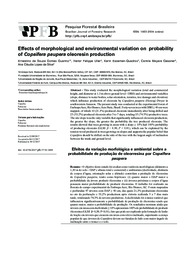Effects of morphological and environmental variation on probability of Copaifera paupera oleoresin production.
Effects of morphological and environmental variation on probability of Copaifera paupera oleoresin production.
Author(s): GUARINO, E. de S. G.; ULLER, H. F.; ESSEMAN-QUADROS, K.; GESSNER, C. M.; SILVA, A. C. L. da
Summary: This study evaluated the morphological variation (total and commercial height, and diameter at 1.3 m above ground level - DBH) and environmental variables (slope, distance to water bodies, solar orientation, termites, tree damage and elevation) which influence production of oleoresin by Copaifera paupera (Herzog) Dwyer in southwestern Amazon. The present study was conducted at the experimental forest of Embrapa Acre, Rio Branco, Acre State, Brazil. Forty-seven trees with DBH > 40 cm were mapped, of which 10 (21.3%) produced oleoresin immediately after being drilled and 25 (53.2%) produced oleoresin after 5 to 7 days, totaling 35 (74.5%) productive trees. The site slope was the only variable that significantly influenced oleoresin production; the greater the slope, the greater the probability the tree produced oleoresin. The results showed that trees growing in areas with a slope ≥ 10% had 100% probability of producing oleoresin (B = 0.38; P < 0.01), which can be explained by the tension wood produced in trees growing on slopes and supports the popular belief that Copaifera should be drilled on the side of the tree with the largest angle of inclination between the trunk and ground level.
Publication year: 2017
Types of publication: Journal article
Unit: Embrapa Acre
Keywords: Acre, Amazonia Occidental, Amazônia Ocidental, Campo Experimental, Condição ambiental, Copaifera paupera, Copaíba, Embrapa Acre, Environmental factors, Essential oil crops, Factores ambientales, Morfologia vegetal, Morfología de las plantas, Nontimber forest products, Oleoresinas, Oleoresins, Oleorresina, Plant morphology, Plantas aromáticas, Productos forestales no madereros, Produto florestal não madeireiro (PFNM), Produção, Rio Branco (AC), Western Amazon
Observation
Some of Embrapa's publications are published as ePub files. To read them, use or download one of the following free software options to your computer or mobile device. Android: Google Play Books; IOS: iBooks; Windows and Linux: Calibre.
Access other publications
Access the Agricultural Research Database (BDPA) to consult Embrapa's full library collection and records.
Visit Embrapa Bookstore to purchase books and other publications sold by Embrapa.

